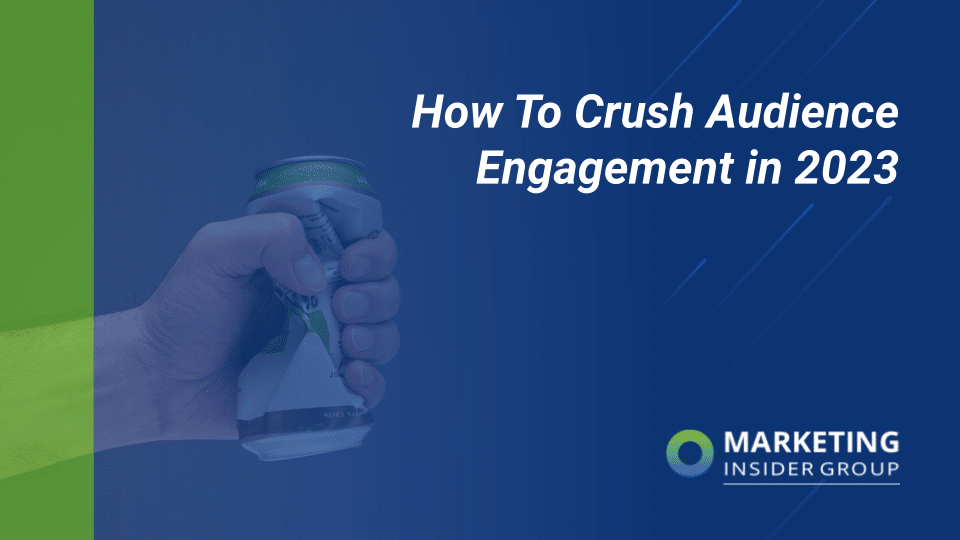
How Employee Engagement Drives Marketing ROI
“Wait a minute,” you say, “Did I read that right? I thought it was our marketing team’s job to sell potential buyers on our products and services, not selling our employees on how great it is to work here. Truth is, driving employee engagement is the marketing team’s most important job.
Without an enthusiastic, engaged team behind it—from manufacturing to inspection to sales and customer service—a product won’t get off the ground.
Instead, you’ll have manufacturing delays, an ineffective campaign, and unhappy customers.
The same goes for companies who sell services. Different details, same results.
A company and its employees are like an orchestra. Although the CEO functions as the conductor, it’s the marketing team who writes the score.
Quick Takeaways:
- A marketing team’s mission is communication. Communication drives trust and enthusiasm. Trust and enthusiasm make for engaged employees.
- Employee activation is a no-brainer if you want to stand out in today’s competitive business environment.
- Empowerment, trust, and a supportive environment are the keys to employee activation.
- Implement a comprehensive employee activation program to consistently get the best out of your employees and turn them into brand ambassadors.
What’s at Stake
If the marketing team doesn’t create:
- The excitement behind the scenes when a new product or campaign launches, you won’t have brand evangelists.
- Enthusiasm among the rest of the teams, you won’t earn the kind of loyalty that produces top-flight work.
- A distinctive brand image and voice, your teams won’t know how to tell your story on-brand.
- Easy-to-understand copy to introduce and explain new products and services, you’ll run into problems with customer support.
- The morale that forges teams out of individual employees, you’ll find that your best people will find another place to work.
That’s why marketing is the key to unlocking employee engagement. Here’s how your team can do just that:
Get Input from All Your Teams
Find out from your engineers how and why your new product works. Create content geared for employee engagement and ask for feedback once it is published. Ask your administrative staff how well your content communicates.
You get the picture. When you bring everyone aboard, you build team spirit among everyone. When you provide the brand guidelines your entire staff needs to use to communicate your message to their circles of influence, you’ll give them the confidence to tell your brand story.
When you ask the other teams in your company for their advice, they will feel important—because they are. They’ll love seeing their ideas in print, in video form, on billboards, and wherever else you post your marketing talent. And you can be sure they’ll take pride in their work—not just their marketing input—but in their regular jobs as well.
Internal communications are every bit as important as communicating your product’s benefits to customers. When you think of your internal teams as your first customers, you’ll keep them on the same page all the way from concept to development to finished product.
Transform Your Culture
We’re not talking about yoga sessions and Matcha tea breaks. We’re talking about a marketing team that leads cultural change from within.
Since marketing teams are in the motivation business, turn that energy around and focus some of it on your own people. Bring out the vision that lies inside every one of your fellow employees.
When you do that, you’ll join the elite 30 percent of American companies whose employees are at least somewhat engaged—body, mind, and spirit—in the company’s mission. That’s huge.
With engaged, focused employees, you’ll not only turn them into brand ambassadors. You’ll have the top talent knocking on your doors.
When prospective employees come in for an interview and see every team in your company in love with their work, they’ll want to sign on. The more your talent pool grows, the more innovation. The more innovation, the better products you’ll have—and better campaigns to showcase them with.
In your company’s transformation, don’t stop with the rank-and-file. Take the elevator to the C-suite.
Though your company’s top executives may be resistant to change, when they see the possibility of growth—and the profits that come with it—they’ll come along for the ride. As a marketing team, you’re in the business of opening people up to possibility.
Take that energy you pour into convincing your customers about your products’ potential to the C-suite. Show them the potential of an engaged workforce.
Partner with HR to Promote Engagement
HR experts, such as Payscale’s Jingcong Zhao, too, see the value of marketing’s role in engaging employees. After all, they’re the department on the line when a disaffected, yet talented employee leaves.
Recruiting, onboarding, and training costs are a drag on a company’s bottom line without anything to show for it. Keeping good employees, engaging those employees, and turning those employees into brand advocates, on the other hand, helps profits to skyrocket.
You could say that engagement is one of the most important components of compensation. No one wants to stay with a company who doesn’t provide recognition for the contributions they make.
As Business Week’s Chad Brooks points out, only 17 percent of unengaged employees experience low-stress levels. That means that 83 percent of them are under stress. Therapy, after all, can eat up a huge chunk of one’s salary.
Which is but one reason HR departments encourage their marketing team to get involved with boosting engagement. As Zhao argues, HR needs to partner with marketing to “forge an alliance and learn from each other.”
- Learn your fellow employees’ pain points: Go beyond the whining about the boss to get to the real issues behind their dissatisfaction. Then teach the team at HR how to help solve their challenges—whether it be through surveys, reading social media posts to find the solution—just like you do in your marketing campaigns with customers.
- Teach HR how to motivate employees: Marketing is all about creating “a compelling vision that motivates customers” to pull the trigger and buy. When you work with your HR department to show employees the benefits—emotional as well as financial—that they’ll realize when they perform at a peak level, they’ll be more likely to catch the company vision. In fact, when employees realize how their work makes a difference in customers’ lives, they’ll commit to the mission.
- Help HR communicate to their “clients”: HR staff often concentrates so hard on the financial compensation, benefit plans, and enrichment programs themselves that they forget to tout their benefits. Marketing teams can play a role when they partner with HR to communicate these perks to the rank-and-file. Whether it’s about transparency in pay to build trust or making your employees aware of that new wellness program, marketing can help build team spirit when it partners with the HR department.
Go from Employee Engagement to Employee Activation
While employee engagement was once thought of as just another “buzzword” or HR trend, it’s now a must. Organizations large and small are realizing the importance of engaging their employees at work for improved productivity and a better working environment. In fact, employee engagement in the US has increased to a high of 34% according to a Gallup report. So what’s next?
Activating your employees.
The trend toward more engaged employees is a positive one, but with pretty much every organization having an employee engagement program in place, you’ll need to take things up a notch to become a business that employees truly feel passionate about working for.

Employee activation is this next step up. Activated employees are not only fulfilled and happy at work, but they’ve developed a true relationship with your organization and a passion for the work they do.
Activated employees act as loyal and authentic brand ambassadors while striving to achieve their maximum career potential. They’re not only high achievers – unlocking your employees’ talent and giving them autonomy in their roles helps to create a more positive work environment, improves colleague relationships, and boosts your brand reputation.
These activated employees are often motivated to create and share content about your company and brand, which can be hugely beneficial for many aspects of your business including marketing, PR, HR, and sales.
Empower Your Employees to Make Their Own Decisions
Over-management will kill off any spark of employee activation before it’s had the chance to take hold. If all main decisions are left to management and the rest of your team is left to simply carry out orders, you’ll be damaging the trust, creativity, and self-confidence of your employees.
Supportive management is hugely important for employee activation, but there’s a big difference between being supportive and being overpowering.
Empower your employees to make their own decisions and take their own risks. Giving individuals this authority, and demonstrating that you value their judgment, skills, and knowledge, can have a significant impact on the team dynamic and overall productivity.
67% of employees who feel empowered at work are willing to put in extra effort, compared to only 4% when empowerment is low.
Giving your employees autonomy over their work and allowing them to make their own decisions about managing their tasks and tackling projects gives them ownership of their work. This helps them to feel more committed to the tasks at hand. They’ll want to succeed on an emotional level rather than purely a professional basis.
Spark Creativity in the Workplace
Part of the benefits of working in an environment where employees are free to follow their own ideas and work in their own unique way is that creativity can flourish.
Creativity is essential for your business to stand out from the crowd. Unfortunately, many employees find that following the same procedures day in and day out in a corporate environment is far from stimulating.
Many of the world’s most successful businesses recognize how important creativity is for activating their employees, and so they offer special initiatives to nurture creative thinking.
Google is the poster-child for fostering a creative environment at work. As well as its innovative workplaces, Google famously allowed each employee to spend 20% of their time at work on their own passion projects in addition to their regular projects.
Most organizations don’t have the same budget and resources available as Google. But it’s still possible to create an environment that encourages creativity.
Give employees the chance to work in different environments. A simple, relaxed break area may spark ideas that would be hard to come by when stuck at a desk. Allowing the opportunity for working from home or a local coffee shop from time to time is another possibility. Allow your employees to work wherever they can focus and come up with their best ideas.
Encouraging collaboration is another very effective way to promote creativity. Mix up your teams and see what happens when individuals work with someone new. Hold regular informal meetings for brainstorming and idea generation.
Invest in Professional Development
Part of triggering employee activation is supporting your employees in reaching their full potential and giving them every opportunity to succeed.
To do this, you need to allocate sufficient time and resources toward staff training and professional development, and make sure each employee has the opportunity to reach his or her goals.
Improving the skills and knowledge of your employees not only helps you to grow a better team over time but it also demonstrates to each individual that you value their needs as well as the needs of the business.
According to a report by LinkedIn, 93% of employees say they would work longer for a company if it invested in their careers. Proving that you value your people will be rewarded with more loyalty, and a higher staff retention rate.
Staff development isn’t all about training them on the latest software or helping them achieve professional qualifications either. “Soft skills” such as leadership, collaboration, and time management can also have a huge impact and can really help to unlock an individual’s true potential.
Build a Content Sharing Culture
One of the biggest benefits of activated employees is that they will promote your company without any incentives or prompting.
However, it takes more than a positive working environment and motivated employees to trigger this content generation and sharing. Once you’ve laid the groundwork in employee engagement, it’s time to implement an employee activation program.
There are many aspects to being successful with such a program. Setting up and promoting guidelines for sharing work-related content on social media is a good start. After that, you can encourage staff-generated content by asking employees to contribute to your content marketing efforts, sharing success stories, and profiling individual employees on your marketing channels.
Getting your employees to be enthusiastic about creating and sharing content is something that will take time, but it’s well worth doing. One-third of consumers trust what an influencer says about a brand more than what the brand says about itself. However, influencer marketing is not without its issues and is not obviously applicable to every industry and market. The solution? Enable your own employees to become brand influencers. This is the true power of employee activation.

Join Forces with Sales to Drive Thought Leadership and Product Education
Winning a sale in today’s demanding market—especially in the B2B arena—requires demonstrating that you are at the forefront of your industry. That takes more than a slick sales presentation.
It takes thoughtful content that shows that your company has researched a customer’s challenges and devised strategies to solve those challenges. It takes informative content that helps your sales team educate customers about how to get the maximum benefit out of your product.
In other words, it takes sales and marketing working hand in hand to win a customer’s business. When you engage your sales team in a mission that goes beyond earning a commission, they’ll never look at a customer the same way again. When your sales team sees their job as helping people solve problems—they’ll be hooked on that kind of high for life.
If you are ready to get more traffic to your site with quality content that’s published consistently, check out our Content Builder Service. Set up a quick consultation, and I’ll send you a free PDF version of my books. Get started today–and generate more traffic and leads for your business.






